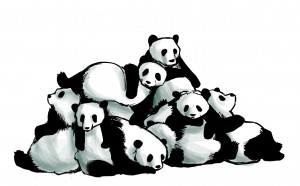Essay by an anonymous survivor, as provided by Christos Callow, Jr.
Illustration by Katie Nyborg
1A.
Ever heard of auto-cloning?
You must have. Everyone knows what it is, though most learned the hard way. I used to know one of the scientists who worked on the project. He died, though, in the process. He died quite a horrible death. He was devoured by a bear.
That is, before bears were tamed. The poor man was part of a larger group of scientists determined to find the solution to all of life’s problems. Or, at least, try. They called themselves The Herbert Easters, after the famous re-animator–-also because they were all either named Herbert or born during the Easter, or at least some of them were and the others were not. Maybe no-one was and some of them lied about it. No-one knows.
The original plan was to create a chemical formula that would instantly tame wild animals. The purpose was to remove violence from the animal kingdom at first, and then from humanity. The first few experiments were total failures. Animals died in the process. Some of the scientists too, including the one I mentioned. Bears that grew too powerful and too aggressive had been created accidentally, and then, at the cost of quite a few lives and quite a lot of money, they were tracked down, killed, and replaced.
These bears were incredibly hard to kill. Their skin was harder than that of a normal bear, and they had increased resistance to pain. They were faster, stronger, and fiercer than they were before the experiments. The Herberts studied their corpses with most interest. They weren’t anywhere nearer their original goal, but they now had new ideas to add to the project. They had almost discovered how to make the bear’s skin impenetrable. They imagined they could do the same with humans. They were more excited than ever. They thought they could discover a way to make both humans and animals immortal. That is, at the expense of fertility, of course. In their utopia there would be no death, but no birth either, and the number of existences would always be the ideal. But first, before changing the entire society, they had to succeed in changing the bears.
Through cloning, they managed to keep some of the bear’s behavioural characteristics out of the clone, and through splicing, they combined bears and pandas. The result was a mutated bear-like creature, calmer than the ordinary, resembling pandas more than bears in everything but the shape and the size. They were black and white in colour, like pandas, and fluffy, and comfortable to sit on. Literally, the scientists would sit on them, tickle them, play with their food, annoy them in any way possible, and the new bears would accept it. They were almost without personality, as their natural aggression had been chemically removed.
There was no way they’d survive in their natural environment. They were tamed pets, dependant on their human masters, yet they were expressionless, indifferent, neutral. The cost of the experiment was the bear’s motivation for life. This new bear did nothing but occupy space. It wouldn’t eat much, as it felt no hunger. It had to be fed, once every day and only a little. It would drink water not for pleasure but in order to not die of dehydration. It was a meaningless mass of meat, sad to look at. Alas, was that the future of the animal that once was the glorious bear?
The Herberts continued their experimenting on the hybrid. Their next objective was to make it self-sufficient, so that it could live without any water or food. I don’t know how they did it. I know it took them little more than a year. I know in the end they made it. The outcome was an Ursus Aeternus-–the immortal bear.

By the end of the day, there was no room in the laboratory for any more bears, yet the bears kept cloning themselves at a steady tempo, ignoring everything that surrounded them.
To read the rest of this story, check out the Mad Scientist Journal: Summer 2012 collection.
The narrator of this story was the last survivor of the bear-apocalypse. A diarist and an old friend of Professor H. P. East of the Herbert Easters, he was one of the “people at the other end of the world” during the apocalypse and witnessed the transformation of Earth to Bearth and the creation of the One-world, free-love, return-to-nature Utopia that was founded on top of the Buddha Bears’ backs and buttocks. Little is known of what became of him, other than that living in the world which the pre-apocalypse people dreamed about drove him to insanity.
Christos Callow Jr. has a BA in Acting, an MA in Playwriting and is currently studying for a PhD in Creative Writing at the University of Lincoln (UK), for which he is researching Utopian/Dystopian fiction and is writing a collection of short stories, exploring utopias of perception such as the Buddhist Nirvana, the Christian “Kingdom Within” and the Lovecraftian Dreamlands.”
Katie Nyborg’s art, plus information regarding hiring her, can be found at http://katiedoesartthings.tumblr.com/
Follow us online: